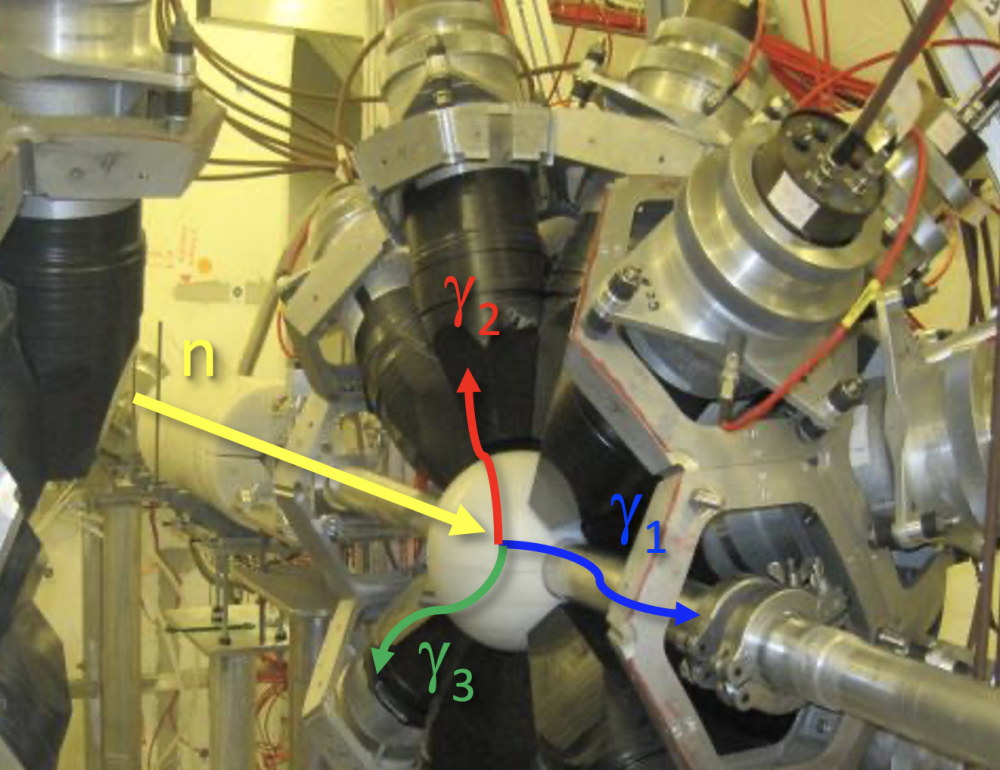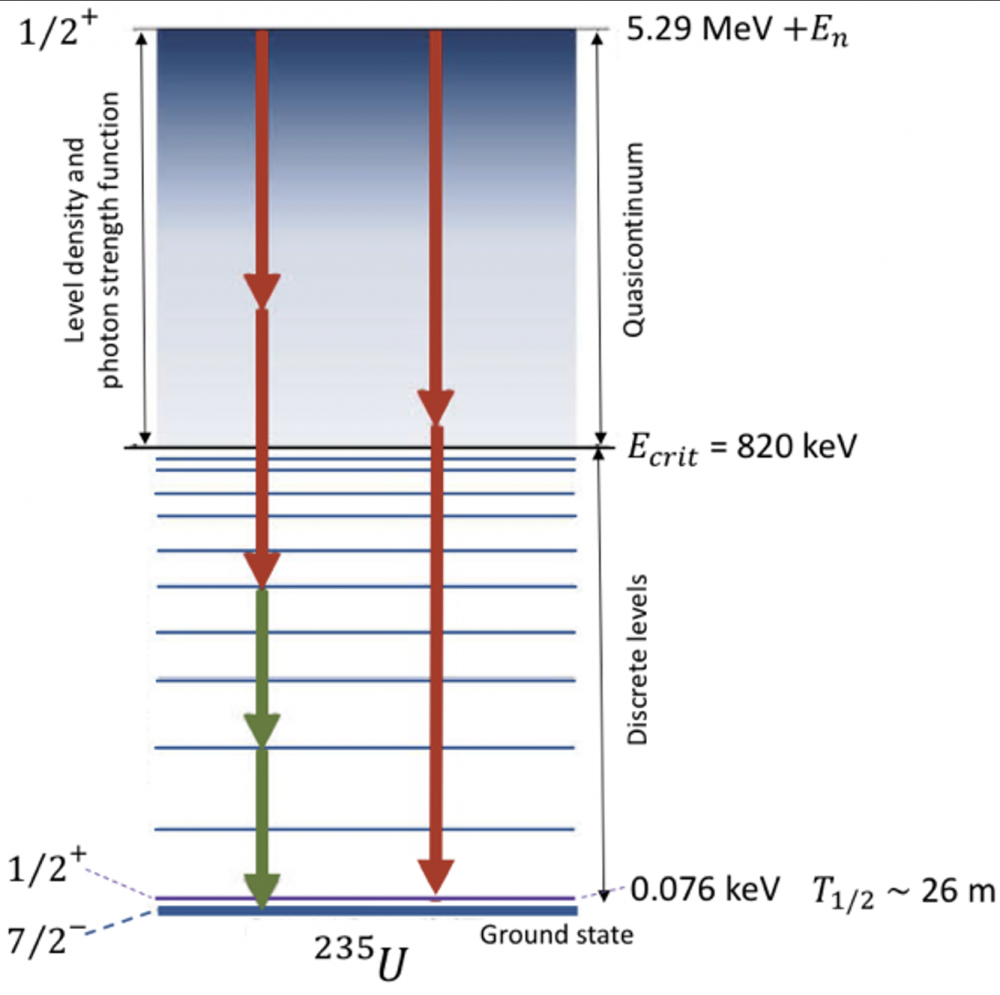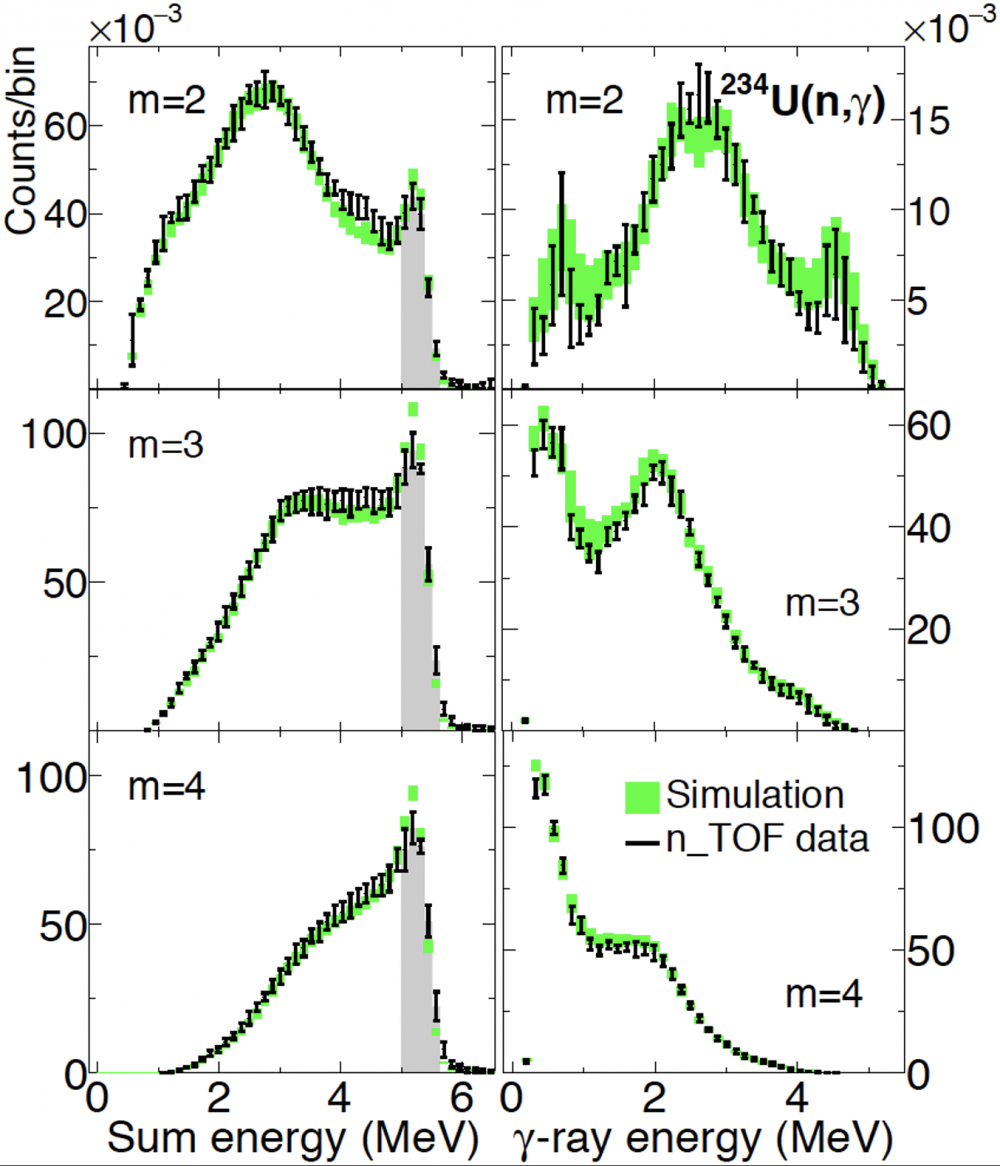The DPhN, in collaboration with the Department of Reactor Studies of Cadarache (DES) and the Institute of Particle and Nuclear Physics of Charles University in Prague (Czech Republic), studied the properties of gamma rays emitted by uranium isotopes during neutron capture reactions. Gamma-ray spectra measured at CERN's n_TOF facility were used as a test bed for nuclear reaction models and their ingredients, including the photon strength function that characterises the ability of a nucleus to emit or absorb photons. This work has enabled consistent modelling of the photon strength functions of the uranium isotopic chain (234U, 236U, 238U) and confirmed the presence of a particular oscillation mode of the nucleus shape at low excitation energy. This study was carried out as part of the PhD thesis of Javier Moreno-Soto [1] and the full results are published in Physical Review C [2].
Like all nuclei, uranium has isotopes, characterised by the same number of protons, 92, but a variable number of neutrons, mainly 146 in the most abundant natural isotope. This isotope of uranium is denoted 238U, where 238 indicates the sum of the protons and neutrons. Uranium isotopes are deformed (non-spherical) nuclei, whose characteristics can be revealed by studying the gamma rays emitted during neutron capture reactions (Figure 1). One of these characteristics is the "photon strength function" which represents the ability of the nucleus to emit (or absorb) gamma rays. Strength functions are an important ingredient in the modelling of nuclear reactions such as neutron capture (n,γ) and inelastic scattering (n,n'γ)* reactions. This function cannot be directly measured, but by comparing simulations and measurements the main properties can be deduced.
*Inelastic scattering is a reaction in which the energy of the scattered neutron is different from the energy of the incident neutron.

Figure 2: Experimental setup (open calorimeter) with illustration of the detection of m = 3 gamma rays emitted during a neutron capture reaction.
The experimental set-up uses the pulsed neutron source n_TOF at CERN and a Total Absorption Calorimeter (TAC) to detect gamma rays (Figure 2).
This device measures the energy (En) of the incident neutrons and the multiplicity (m) and energy (Eγ) of the gamma rays emitted during the capture reactions. In the example shown in Figure 2, m = 3 gamma rays are detected whose sum of energies is equal to the excitation energy of the compound nucleus, i.e. Sn + En where Sn is the binding energy of the captured neutron (Sn = 5.29 MeV for 235U).
Once the measurements have been made at CERN, the interpretation of the data is based on simulations. These are carried out using the Monte Carlo code Geant4 , taking into account the experimental effects affecting gamma rays, from their emission in the uranium sample to their detection in the calorimeter. The core of these simulations is an electromagnetic cascade model based on two essential ingredients:
This model is implemented in the Fifrelin (developed by the DES) and Dicebox (developed by Charles University in Prague) codes, whose algorithm is illustrated in Figure 3.

Figure 3: Modelling of the de-excitation of the residual 235U nucleus after a 234U(n,?)235U capture reaction. The nucleus changes from an excited state (E* = 5.29 MeV + En) to its ground or metastable state via an electromagnetic cascade consisting of, for example, m = 4 gamma rays (left cascade) or m = 2 gamma rays (right cascade). These cascades are simulated by randomly drawing levels and transition probabilities taking into account the level densities and the intensity of the photon strength functions.

Figure 4: Comparison of simulated and measured data for gamma rays emitted by 235U after the 234U(n,?) capture reaction.
The simulated and measured data are compared in Figure 4 for multiplicities m = 2, 3, 4 of the gamma rays emitted during the 234U(n,γ) reaction. In all cases the distribution of the sum of the gamma-ray energies is perfectly reproduced, in particular at the value of Sn (peak in the shaded area of the graphs in the left-hand column). For this value, the gamma-ray energy distribution (right column) is also well reproduced.
The excellent result of these simulations is largely due to the consideration of a specific oscillation mode of the nucleus shape at low excitation energy. This mode is interpreted as the oscillation of the neutrons and protons constituting the nucleus in a scissor-like motion, hence the name scissors mode. The latter is modelled by two peaks around 2 and 3 MeV in the photon strength function shown in Figure 5. The "MGLO(3.0)" model used in this work allows to reproduce in a consistent way with a single set of parameters all the gamma spectra measured at n_TOF during capture reactions on the uranium isotopes 234U(n,γ), 236U(n,γ) and 238U(n,γ). Modelling of these measurements shows a larger contribution from the scissors mode than other models.
This work exploited new observables measured at the n_TOF facility and extracted nuclear structure information, such as photon strength functions, by means of comprehensive simulations, from the nucleus de-excitation cascade to the detection of gamma rays in the experimental setup.
This study confirms the presence of the scissors mode in the oscillation modes of the uranium nuclei shape. The methodology developed could be extended to the study of other nuclei already measured at n_TOF or even lead to new measurements to complete our knowledge on the structure of deformed nuclei.
This work was carried out as part of the PhD thesis of Javier Moreno-Soto [1] and the full results are published in Physical Review C [2].
[1] J. Moreno-Soto, Study of the photon strength functions and level densities in the gamma decay following neutron capture on the isotopes 234U, 236U and 238U, Thèse de Doctorat de l'université Paris-Saclay, 2020;
[2] J. Moreno-Soto, et al. (The n_TOF Collaboration), Constraints on the dipole photon strength for the odd uranium isotopes, Physical Review C 105 (2022) 024618;
• Structure of nuclear matter › Nuclear reaction dynamics
• Institute of Research into the Fundamental Laws of the Universe • The Nuclear Physics Division
• LEARN - Study and Applications of Nuclear Reactions
• nTOF
